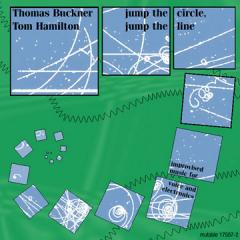THOMAS BUCKNER & TOM HAMILTON / Jump the Circle, Jump the Line
Thomas Buckner (vocal music); Tom Hamilton (electronic music and voice processing)
"This is the kind of music that backs my dreams (& occasionally my nitemares) up! A totally different (but quality) musical adventure." - Rotcod Zzaj
Improvised music for voice and electronics. Vocal music by Thomas Buckner; electronic music and voice processing by Tom Hamilton. "After a decade of wringing inspiration from observation, it is with great pleasure and some relief that I’ve returned (for awhile) to making pieces that address essentially formal procedures. This performance uses techniques of analog electronic synthesis to structure, phrase and pace the music, as well as to generate the actual sound material.
"Revisited here is my crackpot theory - that art after Euclid has been in a constant state of decline. What can I imagine to be more perfect than the representation of circle, square and triangle? So while I try to reflect on the musical analogies, I strive to displace and subvert the inherent symmetry of that visualized ideal; music balanced by instability." - Tom Hamilton
"Thirty-five years ago when I began to explore solo and group improvisation the idea was to make improvisations that sounded like compositions. I’ve evolved away from this idea gradually to the point where I want my improvisations, both solo and group, to sound (and be) unpredictable—to take me, my fellow improvisers and the audience to places we haven’t been before.
"For this piece Tom Hamilton and I decided to carry independence as far as we can. Each part is developed independently, and the goal is not to modify our independent ideas in the act of putting them together. The "wild card" in this practice is the live electronic processing of the voice, for which Tom has developed a system that guarantees unpredictability while integrating the voice into the electronic soundscape. The result is an organic whole with independent but integrally connected parts." - Thomas Buckner
TRACK LIST
Segment A (6:22)
Segment B (5:55)
Segment C (3:16)
Segment D (4:29)
Segment E (10:37)
Segment F (5:49)
Segment G (3:49)
Segment H (4:37)
Segment I (5:08)
Segment J (9:27)
REVIEWS
Rotcod Zzaj, Improvijazzation Nation #54
A brand-new release from Mutable Music (a label we are rapidly becoming acquainted with, due to the package of 3 CD's they just sent). On this disc, an exploration of vocal sounds & electronics takes place... & it's one you're not likely to soon forget. This is the kind of music that backs my dreams (& occasionally my nitemares) up! A totally different (but quality) musical adventure. Buckner's vox are fluid, not at all boring & challenging to listen to, especially in combo with the electronic wizardries that Hamilton pulls off. Though they have segmented the album in to "tracks", it appears (sonically) to be 59 or so minutes of pure fun for them! The real shifts seem to come with the electronics as they "move" into different shades on the palette... Buckner is right there on the changes, using his voice at one point as a thunderstorm to back up a particularly dark passage... or (almost) singing a lullaby when the instruments play little bell-like sounds that (may) take the listener all the way back to the nursery. For listeners unaccustomed to sounds that don't "fit the patterns", this WILL be strange... but if your ears are tired of the normal claptrap on the waves today - you will agree with me when I declare this to be HIGHLY RECOMMENDED. Great stuff!
François Couture, All-Music Guide
This duo has been working together since the early 1990s and has been documented before (on Tom Hamilton's CD Off-Hour Wait State, for example), but never as extensively as in this case. Jump the Circle, Jump the Line was recorded live on December 1st, 2000. Hamilton produces a wide array of synthesized electronic sounds and, to a lesser extent, processes Thomas Buckner's voice. The latter alternates between textural noise-making and deep sustained notes. The album is comprised of a single, continuous improvisation (indexes have been added for convenience, hence the track titles Segment A,2, Segment B,2 etc.). The singer gracefully leaves control of the stage to Hamilton, whose presence will be heard constantly from the first second to the last. Buckner lets him establish a pace before entering and often retreats to give him a chance to modify the path of the piece. As Buckner argues in the liner notes, this music was not about meeting the other halfway. Each improviser follows his own direction and ideas, with the difference that the singer does not have all of his freewill. Hamilton's processing, although light, occasionally sends him hiking on a different track. The electronic soundscapes can get very space-born, as in Segment E2 and in general sound better, more focused and less gimmicky than on Peter Zummo's Slybersonic Tromosome. Released only a few months after Buckner and Roscoe Mitchell's free improv date 8 O'Clock: Two Improvisations, this CD acts like a companion, completing the picture of the singer's activities at the turn of the century.

